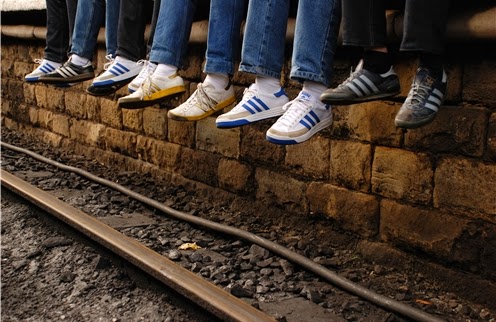Casual
The casual subculture is a subsection of association of football culture that is typified by football hooliganism and the wearing of expensive designer clothing
(known as "clobber"). The subculture originated in the United Kingdom
in the early 1980s when many hooligans started wearing designer clothing
labels and expensive sportswear in order to avoid the attention of
police and to intimidate rivals. They did not wear club colours, so it
was allegedly easier to infiltrate rival groups and to enter pubs. Some casuals have worn clothing items similar to those worn by mods
History
British football support has had a strong fashion-led subculture element since the rise of the Teddy Boya in the mid-1950s. This continued with the mods of the early 1960s, the skinheads of the late 1960s (and later), and the mod revivalist of the late 1970s. The early 'casual' look [pre 1980] was a direct descendant of the mid 1970's 'soul boy' scene. A scene frequented by both black and white people united in their love of jazz funk/ soul music . South East London was a particularly strong area for this [as were others i.e. the 'Angel' area of London] and is a good example of how the 'look' evolved. In 1977 from a mixture of cultures and styles emerged what was the embryonic 'casual' . Straight jeans, trainers, polo shirts and tracksuit tops were combined to create the 'look'. Some of this group went to football and the scene grew from there. The early London 'casual' look from 1977 may have consisted of straight 'Fiorucci' jeans, Adidas, Gola or Puma trainers, Lacoste polo shirts, Gabicci jumper/cardigans, lambswool jumpers, tracksuit tops and a 'wedge' or plain, short 'side parting' haircut. It had no name at first and was just considered a 'smart' look . It evolved and moved on picking up pace and emerged post 1980 as a huge subculture characterised by expensive sportswear such as Fila , Tacchini and Diadora [and many others] reaching it's zenith around 1982-83 from where on the 'look' changed to be more 'designer' orientated eg. {stone island,Fred Perry and Lyle&Scott }.
1970s to 1980s Era
The clothing and fashion aspect of the casual subculture began in the late 70s after fans from Liverpool Football Club introduced the rest of England to European fashions that they somehow acquired while following their teams at European games. These fans returned to England with expensive Italian and French designer sportswear. They brought back many unique clothing brands that had not been seen before in the country. Soon, other fans were clamouring for these rare items such as Lacoste and Sergio Tacchini shirts, and unusual Adidas trainers. At the time, many police forces were still on the lookout for skinhead fans wearing Doc Martens boots, and paid little attention to fans in expensive designer clothing. Although most football fans associate the onset of casual clothing with Liverpudlian hooligans, Manchester United hooligan Colin Blaney has written in his autobiography 'Undesirables' that a subculture known as the 'Perry boys' came into existence in the mid-70s that acted as the precursor to this movement. It consisted of Mancunian football hooligans, who styled their hair up into a flick and wore sportswear and Dunlop Green Flash trainers. Fashion trends frequently changed, and the casual subculture reached its peak in the late 1980s. With their continual desperation not to be out-done and the arrival of the acid house, rave and Madchester music scenes, the violence of the casual subculture faded
1990s and 2000s Era
In the mid-1990s, the casual subculture experienced a revival, but emphasis on style had changed slightly. Including adding labels like Fred Perry, Stone Island, Ralph Lauren, Lacoste, Ellesse and Armani. Many football fans adopted the casual look as a kind of uniform, identifying them as different from the ordinary club supporters. In the late 1990s, many football supporters began to move away from the brands that were considered the casual uniform, because of the police attention that these brands attracted. Several designer labels also withdrew certain designs from the market after they became associated with casuals.
Casual fashion experienced an increase in popularity in the 2000s, with British music acts such as The Streets and The Mitchell Brothers sporting casual outfits in their music videos. Although some casuals have continued to wear Stone Island clothing in the 2000s, many have detached the compass badge so as to be less obvious. However, with the two buttons still attached, those in the know are still able to recognise the clothing items. Many casuals have adopted a more subtle and underground look, avoiding more mainstream clothing brands for independent clothing labels.
Casuals United, also known as UK Casuals United, is a British anti-Islamic protest group that formed in 2009. It is closely affiliated with the English Defence League, a far right street protest movement which opposes what it sees as the spread of Islamism, Sharia law and Islamic extremism in England.
Source

Tidak ada komentar:
Posting Komentar